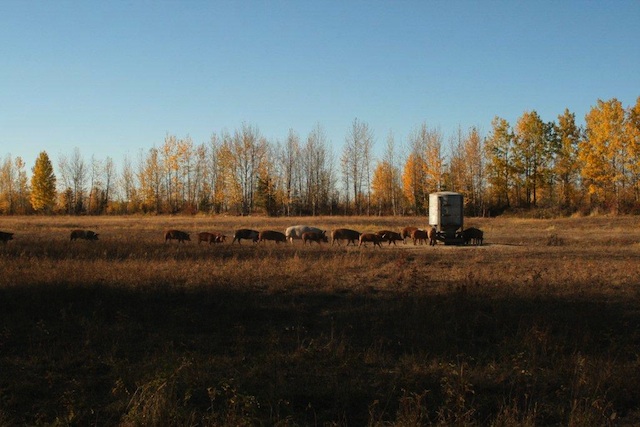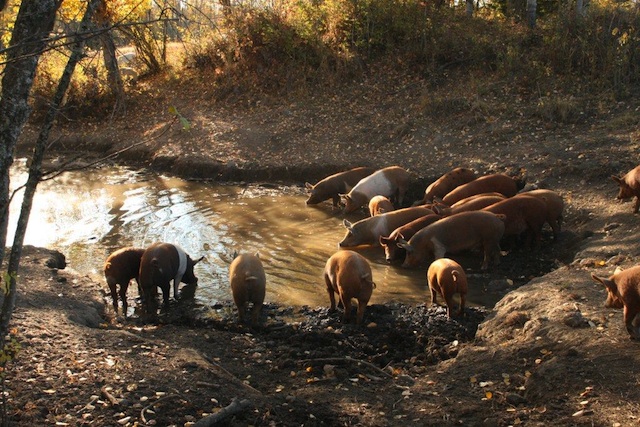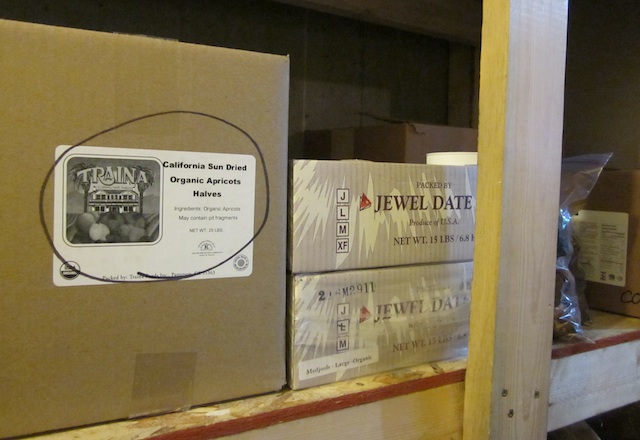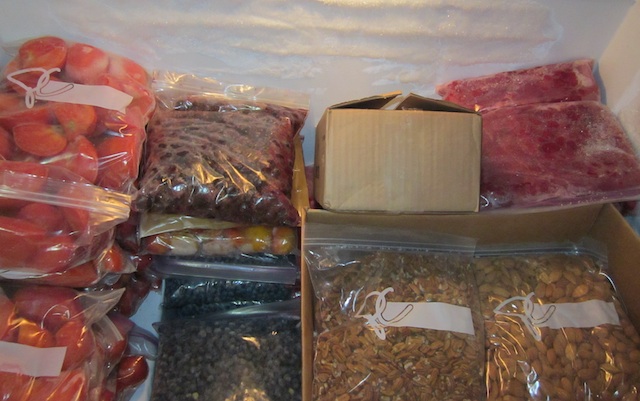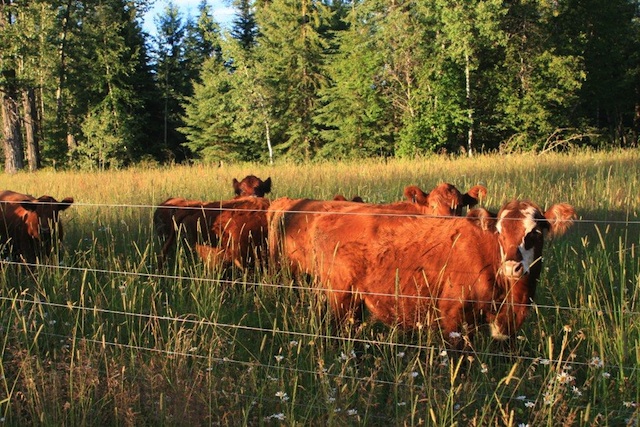
Big Bear Ranch is a unique constellation of 2500 acres of certified organic fields and forests accessible to the animals.
?I dislike the thought that some animal has been made miserable to feed me. If I am going to eat meat, I want it to be from an animal that has lived a pleasant, uncrowded life outdoors, on bountiful pasture, with good water nearby and trees for shade.?
What are People For? by Wendell Berry
I received this very touching letter from Gigi and Rainer Krumsiek from Big Bear Ranch that I wanted to share with you. They are very worried about our government issuing long-term water withdrawal licenses for the shale gas industry. Even though they completely control their watershed — unlike most of us — they understand the priceless value of clean water.
It is heartwarming to know that farmers like Gigi and Rainer are committed to growing the best food possible. But there are many problems outside the control of the homestead or household. We need to work together to send a powerful message to our governments to stop externalizing costs into the greater environment for the dubious benefit of increasing government revenues or enriching a few corporations or individuals. As a population, we need to stop asking our government for services so they will stop spending money that our children and grandchildren will have to pay back.

Happy hogs enjoying a good wallow in a pond. These hogs are destined for the table but that doesn’t mean they shouldn’t have a full and joyous life.
Dear Friends,
Because of all the news lately about possible contamination of commercially raised meat — like this article today — we feel the need to assure you that all our animals are only eating what mother nature intended them to eat.
The only addition to food grown organically on our place is salt — mostly Redmonds Sea Salt — but sometimes salt with selenium, because our soil here is selenium deficient. We use kelp, which is a dehydrated sea plants containing over seventy minerals and vitamins, and certified organic hog and poultry grower mash. We also ask the manufacturer for mash without soy or corn. We are very concerned about cross-contamination from genetically modified soy and corn fields, considering that 85-90% of all corn and soy produced on this continent is already genetically modified.
A very good example of the screwed thinking humans are able to do is the way the corporate industry wants to protect you from bad E. coli. They’ve invented a vaccine against E. coli and want to force the beef producers to use it on every animal by law. The most logical way to prevent E. coli in the first place would be to raise animals with lots of space and sunshine and to not feed them stuff which raises their pH so much that their E. coli becomes resistant against our stomach acid.
Those of you who attended our Field Day or visited us otherwise?could observe the unique constellation of the 2500 acres of certified organic fields and forests accessible to the animals of Big Bear Ranch. We are situated around the highest point in our surrounding, being the source of four little creeks. That means besides the minuscule chance of air pollution no other contaminants can enter our fields. Another advantage is the absence of public roads across our place. This in addition to the fact that all our meat animals are born on our place — some other producers buy animals at the auction market in spring and sell them in fall, which is way more profitable — gives us the confidence to claim that our meat is the healthiest you can possibly buy.
Please help us to protect this rare opportunity by signing the following petition:
Don’t Give Away Our Fresh Water for Fracking
We feel it is time to stop polluting everything just for the advantage of a very few. Here is more information about fracking.
Fracking Threatens Farms and Food Safety
Thank you very much for your time and help.

Sheep and lambs grazing on pasture at Big Bear Ranch. Note how electric fencing is used to control grazing. This ensures the animals always have fresh, clean pasture to eat.
Big Bear Ranch
Rainer and Gigi Krumsiek
PO Box 128, Horsefly, BC, V0L 1L0
T: 250.620.3353, F: 250.620.3393
E: info(a)bigbearranch.com
www.bigbearranch.com
305km
certified organic PACS farm no.16-250: organic grass-fed beef, pastured pork, pastured lamb, raw honey, pet food, custom lumber; breeders for Icelandic ponies, Tamworth pigs, Galloway cattle
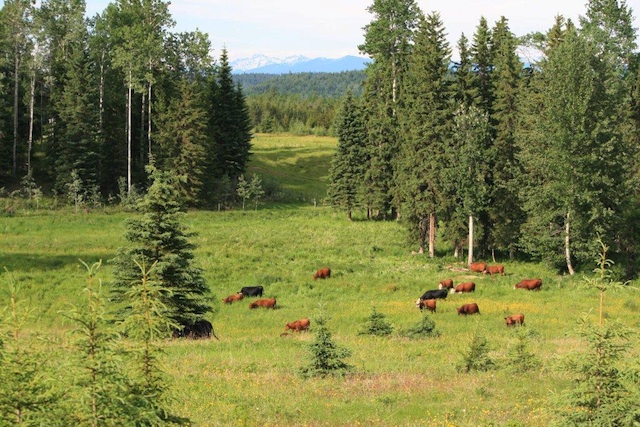
Seeing a place like Big Bear Ranch makes me believe we can learn to live in balance with our environment.
Many specialists believe that feeding grain to a ruminant acidifies their gut and has caused the evolution of acid tolerant strains of Escherichia coli such as 0157:H7. These strains of E. coli can get through our stomach acid and make us very sick or kill the weak among us. For more information please see Slaughtering in BC: Information You Need to Know.
If you would like to learn more about fracking and the unintended consequences to our water and food supply please see Fracking Our Food Supply by Elizabeth Royte. It is a long article but please read it. If we do not act, we better get used to the idea of our children and grandchildren getting cancer at ever increasing rates. When I think about Canada using natural gas and water from the Athabasca River to transform bitumen into oil, I want to weep at our collective stupidity.
A Smoking Gun on Athabasca River: Deformed Fish
The Nature of Things: Tipping Point: The Age of the Oil Sands
We are working towards our own local environmental disaster here in Kamloops. Please see Pick Your Poison or Change Your Life. If you want to read about what you can do on a household level please see What if? and Port-fool-you.
?Do unto those downstream as you would have those upstream do unto you.?
Wendell Berry
Updated May 4, 2013: Last week I was talking with Todd Stone, Kamloops South candidate for the BC Liberals, about his government’s policy to promotion fracking. He says fracking has a forty year history in BC and is totally safe due to government regulations. He told me the problems with fracking can’t happen here in Canada because Canada has the best regulations in the world. I contacted Big Bear Ranch for evidence about fracking damage in Canada.
These two videos are about?Jessica Ernst from Rosebud, AB. Jessica Ernst worked for the last thirty year in the Oil and Gas Industry as a Environmental Scientist. The first video is a six minute introduction. The second video is the documentation of the contamination that occurred in Rosebud, AB. Presently, Jessica Ernst is suing EnCana Corporation and the Alberta Government for water contamination. If you want your children to be able to drink clean water please watch both videos.


